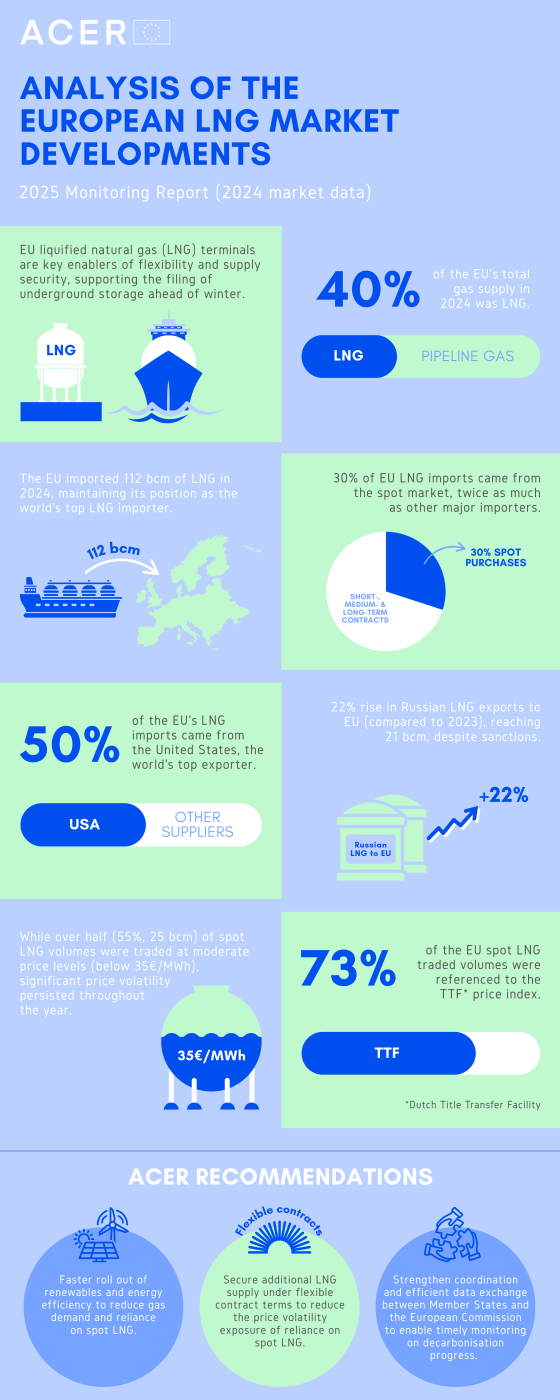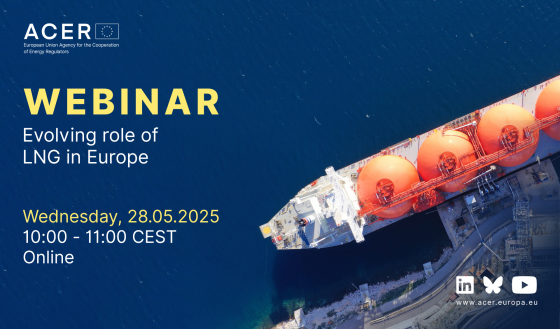was imported by the EU in 2024, keeping it the world’s largest LNG importer.
ACER’s new REMIT tools for EU energy market data

Workshop: ACER’s new cost efficiency comparison of EU gas TSOs
Workshop: ACER’s new cost efficiency comparison of EU gas TSOs

ACER on ENTSO-E’s 2024 draft ten-year electricity network development plan: progress made, but room for improvement
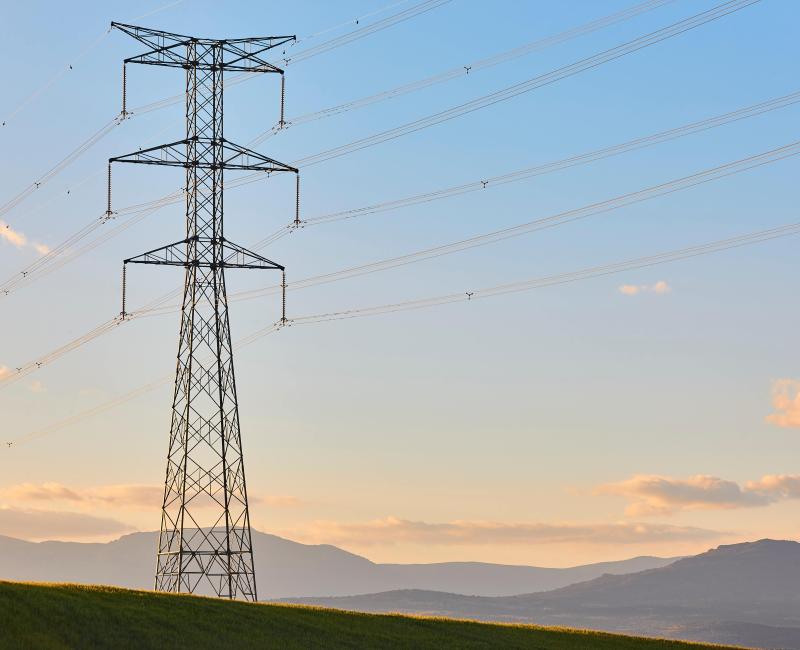
ACER on ENTSO-E’s 2024 draft ten-year electricity network development plan: progress made, but room for improvement
What is it about?
ACER publishes today its Opinion on the draft electricity ten-year network development plan (TYNDP) 2024 and the Infrastructure Gaps Identification report 2024, submitted by the European Network of Transmission System Operators for Electricity (ENTSO-E).
What is the TYNDP and why is it important?
Cross-border electricity infrastructure is key to interconnecting Europe’s electricity markets, making it easier to share electricity across countries. This is important to integrate more renewables onto the grid and achieve ambitious decarbonisation goals.
Every two years, European grid operators submit their draft EU-wide ten-year network development plan (TYNDP) to ACER for its opinion. Given the scale of infrastructure needs and that related costs are expected to make up a growing share of electricity bills, having a robust and fit-for-purpose TYNDP is key to efficient grid development.
The TYNDP is expected to play a central role by identifying cross-border energy infrastructure needs and ensuring that projects bringing the most benefit for the EU are put forward.
On 9 April 2025, ENTSO-E submitted its 2024 draft TYNDP to ACER, along with the electricity Infrastructure Gaps Identification report. Developed within the framework of the TYNDP 2024, the latter provides a pan-European view of future power system needs up to 2050, focusing on cross-border infrastructure and storage capacities. It highlights where current or planned electricity projects might be insufficient to meet those future needs.
In its Opinion 04-2025, ACER provides recommendations to be addressed by ENTSO-E to finalise its 2024 TYNDP and prepare future editions. ACER’s recommendations aim to support investment decisions and facilitate the efficient development of the European electricity grid, in line with broader EU policy goals.
What are ACER’s main findings and recommendations on the 2024 draft TYNDP?
ACER welcomes the progress made so far and acknowledges ENTSO-E’s continued effort to introduce improvements in each new edition of the TYNDP.
ACER finds that the 2024 draft TYNDP generally contributes to the objectives of non-discrimination and effective competition but does not sufficiently contribute to the efficient functioning of the electricity market or ensure an adequate level of cross-border interconnection open to third-party access.
While recognising the complexity of the TYNDP process within its two-year timeframe, ACER notes that several of its previous recommendations remain unaddressed, including the need to improve timeliness and transparency. Other aspects, like enhancing the granularity of the information provided, also need to be addressed.
What does ACER recommend to ENTSO-E for future electricity TYNDPs and Infrastructure Gaps Identification reports?
Ensure timely submission of the TYNDP and of the Infrastructure Gaps Identification report to ACER by addressing the root causes of the recurring delays.
Conduct substantial consultations on assumptions and methodologies used, well before the drafting begins.
Strengthen the medium-term analyses (over a 10- or 15-year horizon) to identify future infrastructure gaps and assess projects’ costs and benefits more effectively.
Improve transparency and consistency of the information on existing grids and projects.
Base the modelling of the electricity network on an appropriate starting grid (for the gaps analysis) and reference grids (for the cost-benefit assessment).
Provide more granular information on infrastructure needs and gaps, including an analysis of capacity constraints within Member States’ networks.
Improve transparency of the cost-benefit analysis (CBA) results and continue work towards full implementation of the 4th CBA Guideline.
Ensure full compliance with ACER’s Scenario Framework Guidelines and its Opinion on ENTSOs’ draft TYNDP 2024 Scenario Report.
What are the next steps?
ENTSO-E is asked to implement ACER’s recommendations both to finalise the 2024 TYNDP and to further improve its upcoming editions.
2025
2025








EU’s reliance on spot LNG likely to continue without stronger decarbonisation
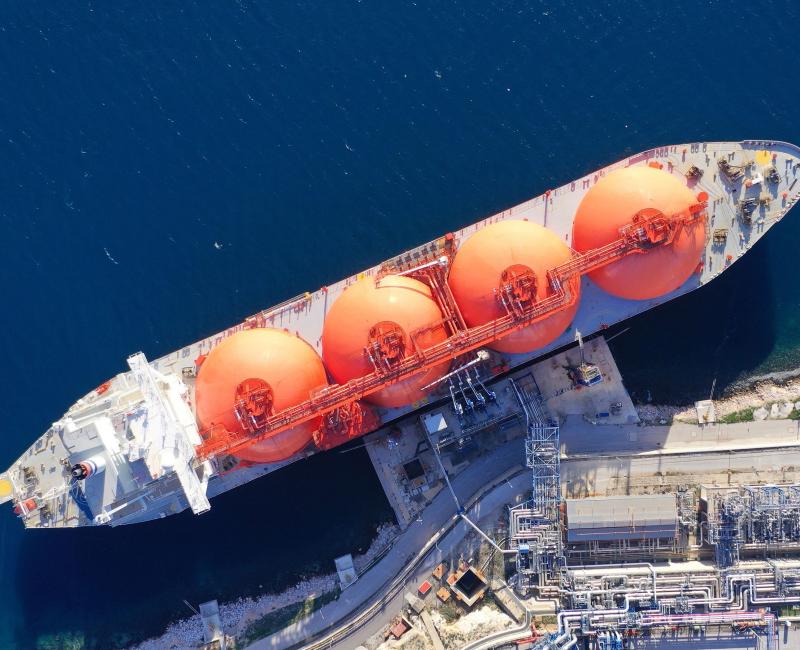
EU’s reliance on spot LNG likely to continue without stronger decarbonisation
What is it about?
As Europe moves away from Russian fossil fuels, liquified natural gas (LNG) is becoming an increasingly important flexible supply source. But with future gas demand uncertain, the EU faces a trade-off: securing higher LNG volumes to ensure stabler pricing, while maintaining the flexibility to avoid over-contracting in a changing market.
ACER’s 2025 Monitoring Report highlights:
- LNG’s share of the EU’s total gas supply rose from 23% in 2020 to around 40% in 2024.
- The EU remained the world’s largest LNG importer, with 112 bcm imported despite a 17% drop from 2023.
- The US supplied nearly 50% of EU LNG imports, while Russian LNG to EU increased by 22%, despite sanctions.
- Over 550 EU spot LNG trades with delivery were reported to ACER, totalling 45.5 bcm – 55% of which were priced below 35 EUR/MWh.
- The EU purchased 30 bcm of LNG on the spot market, more than any other major importer.
- The EU faces up to 90 bcm of demand uncertainty between Fit for 55 and REPowerEU scenarios, which could lead to 30 bcm in additional LNG demand by 2030 (compared to 2024 levels) and prolonged reliance on the spot market.
ACER recommendations
To manage future gas demand uncertainty and price risks, key actions are needed from policymakers, network operators and market players:
- Accelerate decarbonisation efforts to reduce structural gas demand through faster deployment of renewables and improved energy efficiency.
- Secure additional LNG through flexible contracts to help reduce short-term exposure to price volatility.
- Improve coordination and effective data-sharing between Member States and the European Commission to enable better monitoring of decarbonisation progress and guide LNG procurement.
What are the next steps?
Register for the ACER webinar on the evolving role of LNG in Europe (28 May 2025).
Analysis of the European LNG market developments
-
 Gas
Gas
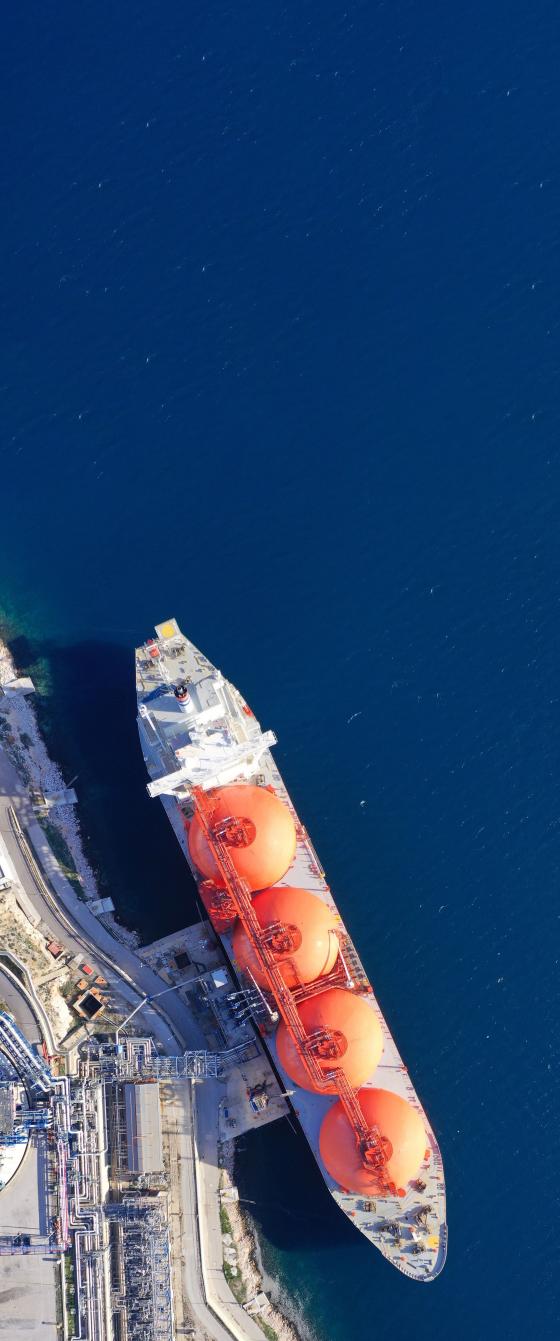
2025 Monitoring Report
As Europe moves away from Russian fossil fuels, liquified natural gas (LNG) is becoming an increasingly important flexible supply source. However, with a growing reliance on LNG and uncertainty around future gas demand (driven by decarbonisation goals), Europe faces a trade-off: securing higher LNG volumes to ensure stabler pricing, while maintaining the flexibility to avoid over-contracting in a changing market environment.
What trends did ACER monitoring find in 2024?
- LNG’s share of the EU’s total gas supply rose from 23% in 2020 to around 40% in 2024.
- Despite a 17% (22 bcm) drop in LNG imports compared to 2023, the EU remained the world’s largest LNG importer, with 112 bcm imported, ahead of both China and Japan.
- The US remained the world’s top LNG exporter, supplying nearly 50% of the EU’s LNG imports.
- Russian LNG exports to the EU increased by 22%, reaching 21 bcm despite sanctions. On 6 May 2025, the European Commission published its REPowerEU roadmap to fully end Russian (pipeline and LNG) gas imports by 2027. The EU must diversify its gas supply without creating new dependencies.
- The EU purchased 30 bcm of LNG on the spot market, more than any other major importer and over twice as much as China or India.
- Over 550 EU spot LNG trades with delivery were reported to ACER in 2024, totalling 45.5 bcm – 55% of which were priced below 35 EUR/MWh.
- TTF continues to be the dominant indexation benchmark, underpinning 73% of EU LNG spot transactions.
- The EU’s LNG demand outlook faces up to a 90 bcm of uncertainty between Fit for 55 and REPowerEU scenarios. Without stronger decarbonisation efforts beyond Fit for 55, the EU could face up to 30 bcm in additional LNG demand by 2030 (compared to 2024 levels).
- Europe’s high reliance on spot LNG is likely to continue through 2030 if progress towards the European Commission’s REPowerEU decarbonisation targets falls short.
- The value of Europe’s LNG import terminals extends beyond utilisation metrics. They provide winter backup, support storage refilling, diversify supply, serve landlocked regions and enhance EU market integration.
ACER recommendations
To manage the uncertainty surrounding future gas demand under the EU decarbonisation targets and to mitigate associated price volatility risks, a balanced strategy is needed – one that combines securing additional LNG supply with accelerated decarbonisation. To achieve this, EU and national policy makers, network operators and market players should focus on the following priorities:
Accelerate decarbonisation efforts to reduce gas demand: Faster deployment of renewables and improvements in energy efficiency will lower overall gas demand, reducing reliance on both spot and contracted LNG volumes. While this strengthens energy security, it also highlights the importance of demand-side decarbonisation.
- Secure additional LNG supply under flexible contract terms: Although gas demand is projected to decline over the medium-term, securing additional contracted LNG volumes would significantly reduce short-term exposure to price volatility. To avoid carbon lock-in and stay aligned with climate goals, new LNG contracts should include destination flexibility for long-term deals or be structured as short- to medium-term contracts.
- Strengthen transparency and coordination across stakeholders: Improved coordination and effective data-sharing between Member States and the European Commission will support monitoring of decarbonisation progress (together with the assistance of ACER, regulatory authorities and the European Network of Transmission System Operators for Gas (ENTSOG)). This will:
- Reduce uncertainty around future gas demand pathways, enabling better-informed LNG procurement.
- Identify early the lagging technologies (that are not developing quickly enough to meet decarbonisation goals), to push for timely policy support or adjustments.
Highlights
-
112 bcm
-
40%
of the EU’s total gas supply came from LNG in 2024, nearly doubling its share since 2021.
-
31 bcm
of LNG was purchased by the EU on the spot market in 2024, with exposure to spot price volatility.
Report
ACER’s 2025 Monitoring Report on the European LNG market developments:
- analyses key LNG import, pricing and trading trends in the EU in 2024;
- assesses Europe’s exposure to spot market and future demand uncertainty; and
- shows how contractual arrangements and decarbonisation progress could help mitigate price volatility risks.
Infographic
Curious about the main numbers and takeaways?
Webinar
ACER will hold a webinar to present the main findings and recommendations of this report.
When?
Wednesday 28 May 2025 at 10:00 CEST.
Additional information
- Access the underlying datasets.
ACER’s latest REMIT Quarterly is out

ACER’s latest REMIT Quarterly is out
What is it about?
ACER’s REMIT Quarterly provides updates on the Regulation on Wholesale Energy Market Integrity and Transparency (REMIT) and related activities, helping stakeholders stay informed on developments that enhance transparency and integrity in the EU energy markets.
What is in the latest REMIT Quarterly?
The 40th edition covers the first quarter of 2025 and marks a decade of progress in centralised EU-wide data collection, which is essential to ensure transparent and fair wholesale energy markets.
This edition includes:
- Updated Q&As on REMIT, which help market participants better understand new obligations under the revised Regulation.
- Overview of 405 potential breach cases under review, along with recent enforcement actions in Spain and France addressing market manipulation.
- Latest improvements in market surveillance, including updated data-sharing statistics, new Energy Identification Codes (EICs) and broader reporting coverage (now including 15,560 standard contracts and 74 organised marketplaces).
- Comparison of Q1 2025 trading activities with Q1 2024, highlighting key market trends and transparency gains.
- Ongoing monitoring of Inside Information Platforms (IIPs), focusing on compliance, data accessibility and improving the effectiveness of public disclosures.
What else is new?
- ACER’s new REMIT Data Reference Centre. Check out the infographic on the first REMIT data released for Q1 2025. Want to know how you can apply the data? See practical examples of how analysts and policymakers can explore market shifts using the ACER REMIT Data Reference Centre.
- ACER’s brand new Inside Information Access Point. This is a single gateway for inside information that is currently published across 23 platforms.
- Interested to find out more about these new tools? Join our webinar (11 June 2025).
